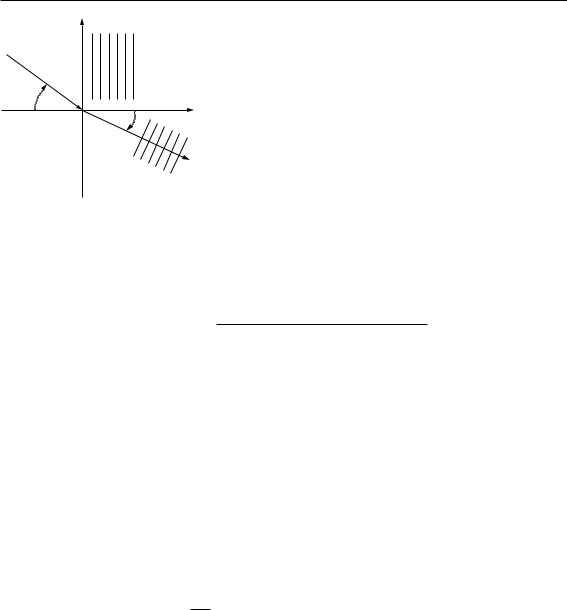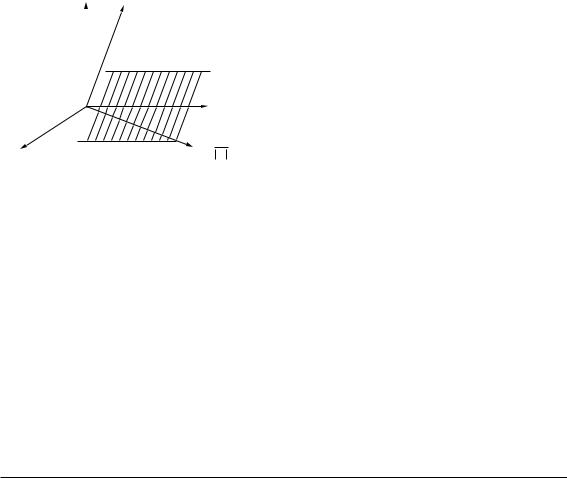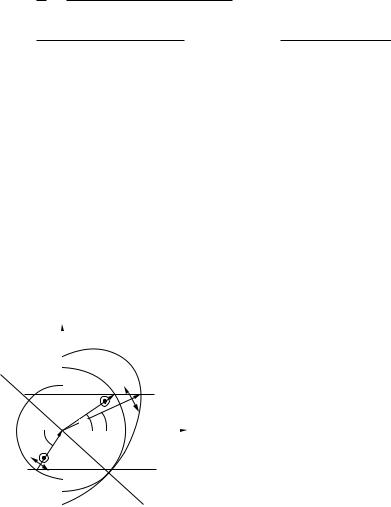
- •Preface
- •Contents
- •1.1 Fundamentals of the semiclassical laser theory
- •1.1.1 The laser oscillator
- •1.1.2.2 Homogeneous, isotropic, linear dielectrics
- •1.1.2.2.1 The plane wave
- •1.1.2.2.2 The spherical wave
- •1.1.2.2.3 The slowly varying envelope (SVE) approximation
- •1.1.2.3 Propagation in doped media
- •1.1.3 Interaction with two-level systems
- •1.1.3.1 The two-level system
- •1.1.3.2 The dipole approximation
- •1.1.3.2.1 Inversion density and polarization
- •1.1.3.3.1 Decay time T1 of the upper level (energy relaxation)
- •1.1.3.3.1.1 Spontaneous emission
- •1.1.3.3.1.2 Interaction with the host material
- •1.1.3.3.1.3 Pumping process
- •1.1.3.3.2 Decay time T2 of the polarization (entropy relaxation)
- •1.1.4 Steady-state solutions
- •1.1.4.1 Inversion density and polarization
- •1.1.4.2 Small-signal solutions
- •1.1.4.3 Strong-signal solutions
- •1.1.5 Adiabatic equations
- •1.1.5.1 Rate equations
- •1.1.5.2 Thermodynamic considerations
- •1.1.5.3 Pumping schemes and complete rate equations
- •1.1.5.3.1 The three-level system
- •1.1.5.3.2 The four-level system
- •1.1.5.5 Rate equations for steady-state laser oscillators
- •1.1.6 Line shape and line broadening
- •1.1.6.1 Normalized shape functions
- •1.1.6.1.1 Lorentzian line shape
- •1.1.6.1.2 Gaussian line shape
- •1.1.6.1.3 Normalization of line shapes
- •1.1.6.2 Mechanisms of line broadening
- •1.1.6.2.1 Spontaneous emission
- •1.1.6.2.2 Doppler broadening
- •1.1.6.2.3 Collision or pressure broadening
- •1.1.6.2.4 Saturation broadening
- •1.1.6.3 Types of broadening
- •1.1.6.3.1 Homogeneous broadening
- •1.1.6.3.2 Inhomogeneous broadening
- •1.1.6.4 Time constants
- •1.1.7 Coherent interaction
- •1.1.7.1 The Feynman representation of interaction
- •1.1.7.3 Propagation of resonant coherent pulses
- •1.1.7.3.2 Superradiance
- •1.1.8 Notations
- •References for 1.1
- •2.1.1 Introduction
- •2.1.3 Radiometric standards
- •2.1.3.1 Primary standards
- •2.1.3.2 Secondary standards
- •References for 2.1
- •2.2 Beam characterization
- •2.2.1 Introduction
- •2.2.2 The Wigner distribution
- •2.2.3 The second-order moments of the Wigner distribution
- •2.2.4 The second-order moments and related physical properties
- •2.2.4.3 Phase paraboloid and twist
- •2.2.4.4 Invariants
- •2.2.4.5 Propagation of beam widths and beam propagation ratios
- •2.2.5.1 Stigmatic beams
- •2.2.5.2 Simple astigmatic beams
- •2.2.5.3 General astigmatic beams
- •2.2.5.4 Pseudo-symmetric beams
- •2.2.5.5 Intrinsic astigmatism and beam conversion
- •2.2.6 Measurement procedures
- •2.2.7 Beam positional stability
- •References for 2.2
- •3 Linear optics
- •3.1 Linear optics
- •3.1.1 Wave equations
- •3.1.2 Polarization
- •3.1.3 Solutions of the wave equation in free space
- •3.1.3.1 Wave equation
- •3.1.3.1.1 Monochromatic plane wave
- •3.1.3.1.2 Cylindrical vector wave
- •3.1.3.1.3 Spherical vector wave
- •3.1.3.2 Helmholtz equation
- •3.1.3.2.1 Plane wave
- •3.1.3.2.2 Cylindrical wave
- •3.1.3.2.3 Spherical wave
- •3.1.3.2.4.2 Real Bessel beams
- •3.1.3.2.4.3 Vectorial Bessel beams
- •3.1.3.3 Solutions of the slowly varying envelope equation
- •3.1.3.3.1 Gauss-Hermite beams (rectangular symmetry)
- •3.1.3.3.2 Gauss-Laguerre beams (circular symmetry)
- •3.1.3.3.3 Cross-sectional shapes of the Gaussian modes
- •3.1.4.4.2 Circular aperture with radius a
- •3.1.4.4.2.1 Applications
- •3.1.4.4.3 Gratings
- •3.1.5 Optical materials
- •3.1.5.1 Dielectric media
- •3.1.5.2 Optical glasses
- •3.1.5.3 Dispersion characteristics for short-pulse propagation
- •3.1.5.4 Optics of metals and semiconductors
- •3.1.5.6 Special cases of refraction
- •3.1.5.6.2 Variation of the angle of incidence
- •3.1.5.7 Crystal optics
- •3.1.5.7.2 Birefringence (example: uniaxial crystals)
- •3.1.5.8 Photonic crystals
- •3.1.5.9 Negative-refractive-index materials
- •3.1.5.10 References to data of linear optics
- •3.1.6 Geometrical optics
- •3.1.6.1 Gaussian imaging (paraxial range)
- •3.1.6.1.1 Single spherical interface
- •3.1.6.1.2 Imaging with a thick lens
- •3.1.6.2.1 Simple interfaces and optical elements with rotational symmetry
- •3.1.6.2.2 Non-symmetrical optical systems
- •3.1.6.2.3 Properties of a system
- •3.1.6.2.4 General parabolic systems without rotational symmetry
- •3.1.6.2.5 General astigmatic system
- •3.1.6.2.6 Symplectic optical system
- •3.1.6.2.7 Misalignments
- •3.1.6.3 Lens aberrations
- •3.1.7 Beam propagation in optical systems
- •3.1.7.2.1 Stigmatic and simple astigmatic beams
- •3.1.7.2.1.1 Fundamental Mode
- •3.1.7.2.1.2 Higher-order Hermite-Gaussian beams in simple astigmatic beams
- •3.1.7.2.2 General astigmatic beam
- •3.1.7.3 Waist transformation
- •3.1.7.3.1 General system (fundamental mode)
- •3.1.7.3.2 Thin lens (fundamental mode)
- •3.1.7.4 Collins integral
- •3.1.7.4.1 Two-dimensional propagation
- •3.1.7.4.2 Three-dimensional propagation
- •3.1.7.5 Gaussian beams in optical systems with stops, aberrations, and waveguide coupling
- •3.1.7.5.1 Field distributions in the waist region of Gaussian beams including stops and wave aberrations by optical system
- •3.1.7.5.2 Mode matching for beam coupling into waveguides
- •3.1.7.5.3 Free-space coupling of Gaussian modes
- •References for 3.1
- •4.1 Frequency conversion in crystals
- •4.1.1 Introduction
- •4.1.1.1 Symbols and abbreviations
- •4.1.1.1.1 Symbols
- •4.1.1.1.2 Abbreviations
- •4.1.1.1.3 Crystals
- •4.1.1.2 Historical layout
- •4.1.2 Fundamentals
- •4.1.2.1 Three-wave interactions
- •4.1.2.2 Uniaxial crystals
- •4.1.2.3 Biaxial crystals
- •4.1.2.5.1 General approach
- •4.1.3 Selection of data
- •4.1.5 Sum frequency generation
- •4.1.7 Optical parametric oscillation
- •4.1.8 Picosecond continuum generation
- •References for 4.1
- •4.2 Frequency conversion in gases and liquids
- •4.2.1 Fundamentals of nonlinear optics in gases and liquids
- •4.2.1.1 Linear and nonlinear susceptibilities
- •4.2.1.2 Third-order nonlinear susceptibilities
- •4.2.1.3 Fundamental equations of nonlinear optics
- •4.2.1.4 Small-signal limit
- •4.2.1.5 Phase-matching condition
- •4.2.2 Frequency conversion in gases
- •4.2.2.1 Metal-vapor inert gas mixtures
- •4.2.2.3 Mixtures of gaseous media
- •References for 4.2
- •4.3 Stimulated scattering
- •4.3.1 Introduction
- •4.3.1.1 Spontaneous scattering processes
- •4.3.1.2 Relationship between stimulated Stokes scattering and spontaneous scattering
- •4.3.2 General properties of stimulated scattering
- •4.3.2.1 Exponential gain by stimulated Stokes scattering
- •4.3.2.2 Experimental observation
- •4.3.2.2.1 Generator setup
- •4.3.2.2.2 Oscillator setup
- •4.3.2.3 Four-wave interactions
- •4.3.2.3.1 Third-order nonlinear susceptibility
- •4.3.2.3.3 Higher-order Stokes and anti-Stokes emission
- •4.3.2.4 Transient stimulated scattering
- •4.3.3 Individual scattering processes
- •4.3.3.1 Stimulated Raman scattering (SRS)
- •4.3.3.2 Stimulated Brillouin scattering (SBS) and stimulated thermal Brillouin scattering (STBS)
- •4.3.3.3 Stimulated Rayleigh scattering processes, SRLS, STRS, and SRWS
- •References for 4.3
- •4.4 Phase conjugation
- •4.4.1 Introduction
- •4.4.2 Basic mathematical description
- •4.4.3 Phase conjugation by degenerate four-wave mixing
- •4.4.4 Self-pumped phase conjugation
- •4.4.5 Applications of SBS phase conjugation
- •4.4.6 Photorefraction
- •References for 4.4

104 |
|
3.1.5 Optical materials |
[Ref. p. 131 |
|
x |
|
|
|
Planes of |
|
|
|
constant |
|
|
|
amplitude |
|
|
|
|
|
|
|
T |
z |
|
|
|
|
|
n |
n ’ ik ’ |
|
|
|
Planes of |
Fig. 3.1.25. Refraction at a medium with absorption: generation |
|
|
constant |
||
|
phase |
of an inhomogeneous wave. |
|
Inhomogeneous wave (Fig. 3.1.25): Snell’s refraction law is modified:
sin ΘT = |
n |
sin Θ |
(3.1.82) |
|
|||
|
nT |
|
|
with
2 n2T = n 2 − k 2 + n2 sin2 Θ + n 2 − k 2 − n2 sin2 Θ 2 + 4 n 2 k 2 (Ketteler’s formula) .
The e ective refractive index nT determines the direction angle ΘT of planes of constant phase in Fig. 3.1.25 via (3.1.82) [88Kle, p. 78], [41Str, p. 503], [99Bor, p. 740]. The full inhomogeneous wave can be calculated using [99Bor, p. 740].
Example 3.1.11. Θ = 45 ◦, Au: λ = 800 nm, n = 0.19, k = 4.9, nT = 0.73, ΘT = 75.1 ◦ (see [28Koe, p. 209]).
Intensity attenuation in the case Θ = 0 ◦:
I = I0 exp {−2 |
(ω/c) k z} . |
|
|
|
|
|
|
|
|
|
|
|
|
|
|
|
− |
|
|
|
|
|
|
(3.1.83) |
||||||
1/e − depth = 13 nm. |
◦ |
, Au: λ = 800 nm, n |
|
= 0.19, k |
|
= 4.9, |
I = I |
0 |
exp |
|
|
× |
|
|
|
|
, |
|||||||||||||
Example 3.1.12. Θ |
= 0 |
|
|
|
|
7.7 |
|
104 z[mm] |
||||||||||||||||||||||
|
p − |
|
s |
|
|
|
|rs| |
|
|
|
p |
|
| |
|
p| |
|
|
|
p |
|
|
s |
|
|
| |
|
s| |
s |
|
|
Ellipsometry: δ |
|
δ |
|
and moduli |
|rp| |
of the reflected light r |
|
= |
|
r |
|
exp (i δ |
|
) and r |
|
= |
|
r |
|
exp (i δ |
) |
|||||||||
|
|
|
|
|
|
|
|
|
|
|||||||||||||||||||||
can be measured. The complex refractive index of a material results [77Azz, 90Roe]. Application: Measurements for the optical constants of metals, semiconductors, and thin-film systems.
3.1.5.7 Crystal optics
3.1.5.7.1 Classification
The dielectric tensor εr = εij in (1.1.8) is symmetrical and real in the case of a nonabsorbing medium.
In Fig. 3.1.26 vectors connected with wave propagation in crystal optics are depicted. In Table 3.1.8 optical crystals are listed. In Table 3.1.9 three of the eight surfaces for visualization of wave propagation in crystals are presented.
Landolt-B¨ornstein
New Series VIII/1A1

Ref. p. 131] |
|
|
|
3.1 Linear optics |
|
105 |
||
|
|
|
|
|
|
|
|
|
E |
|
|
D |
|
|
|
|
|
|
|
|
|
|
|
|||
|
|
|
|
|
|
|
|
|
|
|
|
Beam edge |
|
|
|
|
|
|
|
|
|
|
|
Fig. 3.1.26. Vectors connected with wave propagation in |
||
|
|
|
|
s |
|
crystal optics [99Bor]: s : ray direction unit vector Poynt- |
||
|
|
|
|
|
|
ing vector E × H, n : unit vector in the normal direction |
||
B, H |
Beam edge |
n = |
k |
k and phase planes, orthogonalities: B, H E, D, n, s ; |
||||
k |
||||||||
|
|
|
|
|
|
E s ; D n. |
|
|
Table 3.1.8. Optical crystals. |
|
|
|
|
|
|||
|
|
|
|
|
|
|||
Classification: |
Refractive index |
|
Optical type |
Example |
Values of the |
|||
system (syngony) |
in the main axis |
|
of crystal |
|
refractive index |
|||
of crystal |
system |
|
|
|
|
for λ = 589.3 nm |
||
|
|
|
|
|
|
|||
triclinic, |
nx = ny = nz = nx |
|
biaxial crystal, no |
NaNO3 |
nx = 1.344 , |
|||
monoclinic, |
|
|
|
ordinary waves |
|
ny = 1.411 , |
||
orthorhombic |
|
|
|
|
|
nz = 1.651 |
||
trigonal, |
nx = ny = no |
|
|
positive uniaxial |
SiO2 |
no = 1.544, |
||
tetragonal, |
(ordinary |
|
|
crystal: no < ne |
(quartz) |
ne = 1.553 |
||
hexagonal |
index) |
|
|
|
|
|
||
|
|
|
nx = nz = ne |
|
|
negative uniaxial |
CaCO3 |
no = 1.658, |
|
|
|
(extraordinary |
|
|
crystal: no > ne |
(calcite) |
ne = 1.486 |
|
|
|
index) |
|
|
|
|
|
cubic |
nx = ny = nz = n |
|
isotropic crystal |
NaCl |
n = 1.544 |
|||
|
|
|
|
|
|
|
|
|
Table 3.1.9. Three of the eight surfaces for visualization of wave propagation in crystals.
Surface |
Given |
Found by construction are the |
|
|
|
Index ellipsoid (indicatrix) |
normal direction n |
D-vectors for the two polarization cases |
(one-shell surface) |
|
and the two refractive indices for phase |
|
|
propagation |
Index surface, wave vector |
normal direction n ray directions s, which are perpendicular |
|
surface (two-shell surface) |
|
to the surface for both polarization cases |
Ray surface, wave surface, representing |
ray direction s |
normal direction n, which is perpendicular |
Huygens’ elementary wave for both |
|
to the surface |
polarization cases (two-shell surface) |
|
|
|
|
|
Main feature of crystal optics: s is not parallel with n for wave propagation, mostly.
–s is essential for description of the energy propagation (edges of bundles, rays),
–n is essential for description of the interferences of infinite broad waves.
References: [28Szi, 54Bel, 58Shu, 61Ram, 76Fed, 79Wah, 84Yar, 04Ber, 99Pau, 99Bor]. A detailed comparison between that surfaces is given in [28Szi].
Landolt-B¨ornstein
New Series VIII/1A1

106 |
3.1.5 Optical materials |
[Ref. p. 131 |
|
|
|
3.1.5.7.2 Birefringence (example: uniaxial crystals)
Uniaxial crystals in the plane of incidence:
–Refraction of the normal direction n of wavefronts: The wavevector surface is shown in Fig. 3.1.27.
sin Θo = |
n |
sin Θ (ordinary wave (ko)) |
(3.1.84) |
||
|
|||||
|
no |
|
|
||
(no does not depend on the angle of incidence), |
|
||||
|
|
n |
|
|
|
sin Θe = |
|
sin Θ |
(extraordinary wave (ke)) |
(3.1.85) |
|
nθ e (Θe(Θ)) |
|||||
(ne depends on the angle of incidence).
–Refraction of rays (Poynting vector): se and so are given by tangent construction in Fig. 3.1.28.
–Algorithm for the calculation of ko ( so), ke, se of Fig. 3.1.28 with n, no, ne, η, θ of Fig. 3.1.29 [86Haf]:
n2(n2o − n2e )2 sin2 Θ sin2(2η) 2 B2
|
|
|
|
|
|
|
|
|
|
|
|
|
|
2 |
|
n2)2 |
sin Θ sin (2η) |
× n2 sin2 Θ |
(n2 |
|
n2)2 |
sin2(2η) |
|
A |
|
||
± |
n(no |
− |
e |
|
o |
− |
e |
|
− 1 + |
|
(3.1.86) |
||
|
|
|
B |
|
|
|
|
B |
|||||
(refractive index for the extraordinary wave)
with
A = (n2e − n2o) n2 sin2 Θ cos (2η) − n2o n2e ,
B = n2o + (n2e − n2o) sin2 η ,
where the decision on the ± sign in (3.1.86) can be made by controlling the satisfaction of
n2θ e n2o + (n2e − n2o) sin2(η + Θe) = n2e n2o .
The resulting angles are: |
|
|
|
||||
Θo = arcsin(n sin Θ/no) , |
|
(3.1.87) |
|||||
|
x |
|
|
|
|||
Optical axis |
|
|
|
|
|
|
|
|
|
|
|
TE |
|
|
|
|
|
k o |
k e |
TM |
|
||
|
|
|
o e |
|
z |
||
|
|
|
|
|
|||
|
|
|
|
|
|
|
|
|
|
|
|
|
|
|
|
|
k |
|
|
|
|
|
|
Polarization |
|
|
|
|
|
|
Fig. 3.1.27. Construction of wavefront birefringence with |
TE and TM |
|
|
|
|
|
|
|
Index n |
|
|
|
Indices no and ne |
the wavevector surface: The wavefronts show no transversal |
||
|
|
|
limitation. |
||||
|
|
|
|
|
|
|
|
Landolt-B¨ornstein
New Series VIII/1A1
